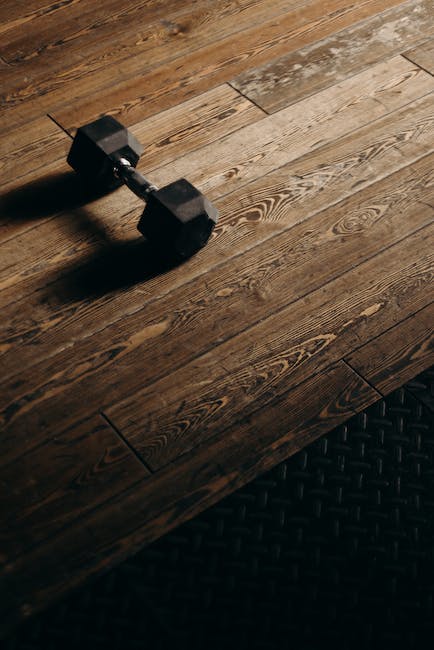Are you tired of constantly dropping things because of elbow tendonitis? Don’t worry, you can still lift… weights that is. While weight lifting can actually improve your tendonitis, it can also be the cause of it. So, let’s dive into the bicep-burning world of weight lifting and elbow tendonitis, and learn how to pump iron without feeling the burn.
Contents
- 1 1. Introduction to Weight Lifting and Elbow Tendonitis
- 2 2. Understanding the Causes and Risk Factors of Elbow Tendonitis
- 3 3. How Weight Lifting can Lead to Elbow Tendonitis
- 4 4. Effective Treatment Options for Elbow Tendonitis in Weight Lifters
- 5 Effective Treatment Options for Elbow Tendonitis in Weight Lifters
- 6 5. Preventing Elbow Tendonitis While Weight Lifting: Tips and Best Practices
- 7 Time to Pump Iron!
1. Introduction to Weight Lifting and Elbow Tendonitis
Weight lifting is a grueling activity that many enthusiasts engage in to achieve that lean muscle they’ve always dreamt about. It’s often an addictive habit because once you see the results, the pull is hard to resist. However, it comes with its fair share of problems, one of them being elbow tendonitis. It’s an inflammation of the tendon that connects your forearm to your elbow, mostly caused by repetitive gripping activities like lifting weights.
One of the most challenging things about weight lifting is how it tends to harden the muscles and make them rigid. This rigidity is especially combined with holding heavyweights puts a lot of pressure on your elbow joint, which leads to the development of elbow tendonitis. It’s vital to understand that the more rigid your muscles are, the more prone you are to develop this condition.
Elbow tendonitis can be excruciating, and it’s worsened by constant movements. It manifests as joint stiffness, swelling and pain that spreads down to your forearms and wrists. Despite how debilitating it can be, there’s no need to stop doing the exercises you love altogether. Taking a break from heavy lifting and opting for low-intensity exercises like swimming or yoga can help relieve the pain. Remember, it’s better to take a break and let your body heal than to push through the pain and cause more damage.
2. Understanding the Causes and Risk Factors of Elbow Tendonitis
Elbow tendonitis can be caused by a variety of factors, all of which make the elbow joint work harder than it needs to. Here are some of the most common causes:
- Overuse – Whether you’re a professional pitcher or just someone who spends too much time scrolling on their phone, overuse of the elbow joint can lead to tendonitis.
- Age – As we get older, our tendons become less elastic and more prone to injury. If you’re over 40, you’re at greater risk of developing elbow tendonitis.
- Health conditions – If you have conditions like rheumatoid arthritis or gout, you’re more likely to develop tendonitis.
But don’t worry, there are plenty of risk factors that you can’t control, too! Here are some things that increase your likelihood of developing elbow tendonitis:
- Being human – Sorry, robots. This one’s just for us organic beings. Humans are more prone to tendonitis because our bodies are designed to perform repetitive motions.
- Having an elbow – Again, sorry, robots. This one’s for the fleshy among us. Having an elbow means that we have a joint that’s prone to injury.
- Existing in the world – Hey, if you’re alive and kicking, you’re at risk for elbow tendonitis. It’s just one of those things.
So, whether you’re an aging human who spends too much time scrolling Twitter or a robot who’s been biding their time waiting for the perfect opportunity to strike, elbow tendonitis is a risk for us all. But don’t worry – in the next section, we’ll talk about how to prevent and treat this pesky condition.

3. How Weight Lifting can Lead to Elbow Tendonitis
How Weight Lifting can Lead to Elbow Tendonitis
Listen up, folks. This one’s for all you gym enthusiasts out there. You might be surprised to learn that your beloved weight lifting routine is not only giving you a hefty pump but also elbow tendonitis. That’s right, you heard it here first. So, what’s the deal with weight lifting causing elbow tendonitis, you ask? Let me break it down for you.
- Repetitive Strain Injury: It’s no secret that weight lifting involves a lot of repetitive motions. And when you do that, you’re putting your elbows under a lot of stress. Over time, that strain can cause tiny tears in your tendons, leading to elbow tendonitis.
- Excessive Stress: We all know that lifting heavy weights can make us feel like superheroes. But sometimes, trying to lift more than we’re actually capable of can do more harm than good. Putting too much stress on the elbows can cause inflammation and lead to elbow tendonitis.
Now, I’m not saying weight lifting is a bad thing. Far from it. But, if you’re experiencing pain or discomfort in your elbows, it might be time to take a break and let your body heal. Besides, you know what they say – “No pain, no gain” – but nobody said that pain had to come from tendonitis.
4. Effective Treatment Options for Elbow Tendonitis in Weight Lifters
Effective Treatment Options for Elbow Tendonitis in Weight Lifters
So, you’ve been hitting the gym hard and now your elbows feel more like rusty hinges than joints? Welcome to the world of elbow tendonitis! But don’t worry, we’ve got some effective treatment options that will have you flexing like Hulk Hogan in no time!
First up, rest. Yes, rest! We know this is a dirty word in the world of weight lifting, but sometimes your body needs a break. Take a few days off from lifting and focus on some low-impact exercises like swimming or yoga. Trust us, your elbows will thank you.
Next, ice and compression. Wrap your elbows in a compression bandage and ice them for 15-20 minutes at a time, multiple times a day. And don’t forget the anti-inflammatory medication! Take some ibuprofen or naproxen to help relieve the pain and swelling.
And finally, physical therapy. Don’t be afraid to seek professional help. A qualified physical therapist can develop a personalized treatment plan for you, including exercises to strengthen the muscles around your elbows and improve your range of motion. Plus, they can also provide some much-needed moral support for those days when you just feel like throwing in the towel.
- Rest
- Ice and Compression
- Anti-inflammatory medication
- Physical Therapy
So, there you have it – effective treatment options for elbow tendonitis in weight lifters. Sure, it may mean taking a break from the gym and resorting to low-impact exercises for a while, but remember – Rome wasn’t built in a day, and neither was Arnold Schwarzenegger’s bicep. Take care of your body, and it will take care of you!
5. Preventing Elbow Tendonitis While Weight Lifting: Tips and Best Practices
Do you want to pump your guns without getting inflammation in your elbows? Of course, you do! Elbow tendonitis can make lifting weights a pain in the butt, or should I say, pain in the elbows. But fear not! Here are some tips and best practices to prevent elbow tendonitis while weight lifting:
- Warm-up: Before lifting those weights, warm-up your muscles and joints. Do some stretching to loosen up your elbow flexors and extensors. Remember, cold muscles and tendons are prone to injury, so don’t skip your warm-up.
- Proper form: Using the proper form while lifting weights is crucial in preventing elbow inflammation. Keep your elbows tucked in, and don’t let them flare out to the sides while doing bench press or push-ups. Also, avoid hyperextending your elbows while doing bicep curls or tricep extensions.
- Rest and recover: Giving your muscles and joints time to rest and recover is essential in preventing elbow tendonitis. Don’t overdo it and lift too heavy or too frequently. Listen to your body, and if you feel any pain, take a break. Also, don’t forget to ice your elbows after a weightlifting session to reduce inflammation.
Elbow tendonitis can be a real bummer, but with these tips and best practices, taking care of your elbows can be a breeze. Remember, warm-up, use proper form, and rest and recover to prevent elbow inflammation while weight lifting. Happy lifting!
Time to Pump Iron!
So there you have it, folks! We hope this article has given you some valuable tips on how to avoid elbow tendonitis while weightlifting. And remember, lifting weights is not just a way to build muscles, it’s a way of life!
So, slap on those lifting gloves, crank up that heavy metal playlist, and start lifting those weights. Just don’t forget to listen to your body and give it the rest and recovery it deserves.
Till then, keep pumping iron and living the gainz life! 🏋️♀️💪








Leave A Comment